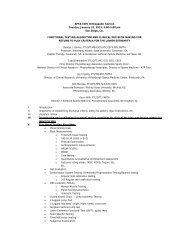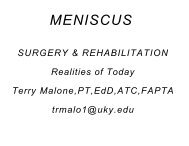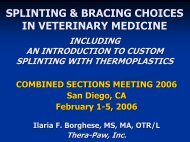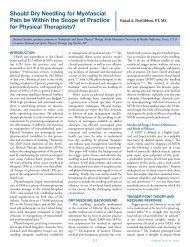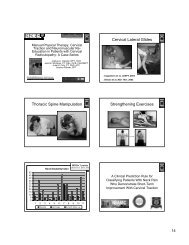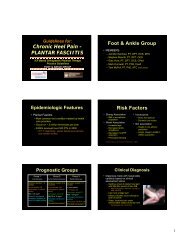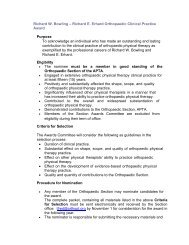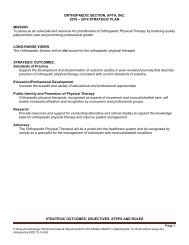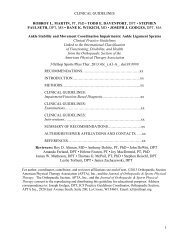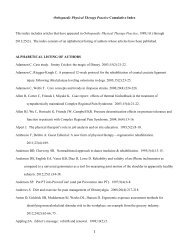Open vs. Closed Chain Exercises for the Knee - Orthopaedic Section
Open vs. Closed Chain Exercises for the Knee - Orthopaedic Section
Open vs. Closed Chain Exercises for the Knee - Orthopaedic Section
You also want an ePaper? Increase the reach of your titles
YUMPU automatically turns print PDFs into web optimized ePapers that Google loves.
<strong>Open</strong> <strong>vs</strong>. <strong>Closed</strong> <strong>Chain</strong> Exercise <strong>for</strong> Tibiofemoral Joint Osteoarthritis<br />
Walter L. Jenkins, DHS, PT, ATC-L<br />
Associate Professor<br />
Department of Physical Therapy<br />
East Carolina University<br />
APTA Combined <strong>Section</strong>s Meeting<br />
New Orleans, LA<br />
<strong>Orthopaedic</strong> <strong>Section</strong>; <strong>Knee</strong> Education Group Symposium<br />
February 26, 2005<br />
I. Introduction<br />
II.<br />
Articular Cartilage<br />
a. Mechanism of Injury<br />
b. Tibiofemoral Joint Biomechanics<br />
c. Clinical Examination<br />
1. tibiofemoral joint alignment<br />
2. observational gait analysis<br />
3. range of motion<br />
4. ligament instability exam<br />
d. Therapeutic Exercise: Theory<br />
1. <strong>Open</strong> <strong>vs</strong>. <strong>Closed</strong> Kinetic <strong>Chain</strong><br />
2. Passive/Active ROM<br />
3. Shear <strong>vs</strong>. Compression<br />
4. Arcs of Motion
e. Therapeutic Exercise: Implementation<br />
1. resisted range of motion<br />
2. open kinetic chain<br />
3. closed kinetic chain<br />
4. functional training<br />
IV. Conclusions
<strong>Open</strong> and <strong>Closed</strong> <strong>Chain</strong> <strong>Exercises</strong>:<br />
Myth, Science, and Clinical Implications<br />
Sean P. Flanagan, PhD, ATC, CSCS<br />
Department of Kinesiology<br />
Cali<strong>for</strong>nia State University, Northridge<br />
and popular<br />
Question conventional wisdom!<br />
“Advantages” of <strong>Closed</strong> <strong>Chain</strong><br />
Activities<br />
• Stimulation of proprioceptors<br />
• Increased joint congruency & stability<br />
• Decreased shear <strong>for</strong>ces<br />
• Enhanced dynamic stability<br />
• More “functional”<br />
Prentice, 1999<br />
Flanagan, CSM 2005 Page 1
What is an open chain?<br />
What is a closed chain?<br />
• Steindler , 1955<br />
Definitions<br />
– <strong>Open</strong> chain - a combination in which <strong>the</strong> terminal<br />
joint is free.<br />
– <strong>Closed</strong> chain - one in which <strong>the</strong> terminal joint meets<br />
with some considerable external resistance which<br />
prohibits or restrains free movement.<br />
More definitions<br />
• <strong>Closed</strong> chain – distal end is fixed (Zatsiorsky, 1998).<br />
• <strong>Closed</strong> chain - motion of one [segment] at one<br />
joint will produce motion at all o<strong>the</strong>r joints in <strong>the</strong><br />
system in a predictable manner (Levangie & Norkin,<br />
2001).<br />
Flanagan, CSM 2005 Page 2
Alternate Classifications?<br />
Dillman, Murray, &<br />
Hintermeister, J Sport<br />
Rehab, 1994<br />
Fixed<br />
Boundary<br />
Movable<br />
External<br />
Load<br />
External<br />
Load<br />
No Load<br />
FEL<br />
FNL<br />
MEL<br />
MNL<br />
What does EMG tell us about<br />
movement classification?<br />
No difference in<br />
integrated<br />
EMG<br />
between<br />
similarly- loaded<br />
push-ups<br />
and<br />
bench-press<br />
Blackard, Jensnen, & Ebben, MSSE, 1999<br />
Flanagan, CSM 2005 Page 3
Biomechanical<br />
similarity<br />
between<br />
squat<br />
and<br />
leg press<br />
Escamilla et al, MSSE 1998<br />
No easy classification<br />
• Distal <strong>vs</strong>. Proximal End Moving<br />
• Single <strong>vs</strong>. Multiple Joints<br />
• Angular <strong>vs</strong>. Linear Resistance<br />
• Machine <strong>vs</strong>. Free Weight<br />
• Seated <strong>vs</strong>. Standing <strong>vs</strong>. Prone<br />
<strong>Closed</strong> <strong>Chain</strong> / <strong>Open</strong> <strong>Chain</strong><br />
is not<br />
a useful<br />
classification scheme<br />
Flanagan, CSM 2005 Page 4
Multiple Joints<br />
WEIGHT BEARING<br />
Linear Resistance<br />
NON-WEIGHT<br />
BEARING<br />
Single Joint<br />
Angular Resistance<br />
Do CC exercises<br />
create greater<br />
proprioception<br />
than OC exercises?<br />
Rationale: CC & Proprioception<br />
<strong>Exercises</strong><br />
With<br />
Greater<br />
Proprioceptive<br />
Input<br />
↑ Proprioceptive<br />
Ability<br />
↑Per<strong>for</strong>mance<br />
Flanagan, CSM 2005 Page 5
MAJOR PROPRIOCEPTORS<br />
PROPRIOCEPTOR<br />
Muscle Spindle<br />
Golgi Tendon Organs<br />
INFORMATION<br />
PROVIDED<br />
Angular velocity, position,<br />
tension<br />
Small changes in voluntary <strong>for</strong>ce,<br />
muscle length during contraction<br />
Joint Mechanoreceptors<br />
Cutaneous Receptors<br />
End Range of motion<br />
Active and passive movement,<br />
region involved, crude rate of<br />
oscillatory movement<br />
Proprioceptive Input and Clinical Assessment<br />
PROPRIOCEPTIVE INPUT<br />
Position Sense<br />
CLINICAL<br />
ASSESSMENT<br />
#Reposition Tests, Responses<br />
to perturbations, postural sway<br />
Joint Motion<br />
Angular Velocity<br />
#Movement detection tests,<br />
responses to perturbations<br />
************<br />
Inertial Properties/<br />
Interaction Torques<br />
**************<br />
#Tests per<strong>for</strong>med at <strong>the</strong> conscious level.<br />
Do CC exercises provide<br />
greater<br />
proprioceptive input?<br />
Flanagan, CSM 2005 Page 6
Type of Exercise and JRS<br />
• Early studies: less reposition error with<br />
CKC<br />
Anderson et al, J Sport Rehabil, 1995<br />
Higgins & Perrin, J Sport Rehabil, 1997<br />
• Errors are similar when amount of<br />
compressive <strong>for</strong>ce is decreased in CKC<br />
Taylor et al, JOSPT, 1998<br />
Bullock-Saxton et al, Exp Brain Res, 2001<br />
Do CC exercises lead to<br />
greater proprioceptive<br />
ability?<br />
Proprioception & Exercise<br />
• Proprioception or balance?<br />
Ashton-Miller et al, <strong>Knee</strong> Surg Sports Traumatol Arthrosc, 2001<br />
• 5 weeks of training did not improve shoulder<br />
JRS in ei<strong>the</strong>r OC or CC groups<br />
Padua at al, J Sport Rehabil, 2004<br />
Flanagan, CSM 2005 Page 7
Is more always<br />
better?<br />
Sensorimotor Integration<br />
• Learning of a motor task is specific to <strong>the</strong><br />
feedback conditions available during acquisition<br />
• In<strong>for</strong>mation used to learn and control a<br />
movement increases in importance as a function<br />
of learning<br />
Proteau et al, Q Journal of Exp Psych, 1992<br />
Does more<br />
proprioception<br />
mean better<br />
per<strong>for</strong>mance?<br />
Flanagan, CSM 2005 Page 8
Proprioception & Per<strong>for</strong>mance<br />
• No significant<br />
correlation b/t<br />
JRS and hop test<br />
Drouin et al, J Sport Rehabil, 2003<br />
Are CC exercises are<br />
safer (more injurious)<br />
than OC exercises?<br />
• Decreased Shear Force<br />
Rationale: CC & Safety<br />
• Increased Co-contraction<br />
Flanagan, CSM 2005 Page 9
Shear <strong>for</strong>ces a function of…<br />
• Type of loading<br />
Lutz et al, JBJS-A, 1993<br />
Wilk et al, Am J Sports Med, 1996<br />
Escamilla et al, MSSE, 1998<br />
Kvist et al, Am J Sports Med, 2001<br />
• Placement of external resistance<br />
Zavatsky et al., Am J Sports Med, 1994<br />
• Amount of compressive <strong>for</strong>ce<br />
Fleming et al, Am J Sports Med, 2003<br />
What about<br />
co-contraction?<br />
Co-Contraction<br />
• Function of free-weights <strong>vs</strong>. machines<br />
• Does not affect anterior shear <strong>for</strong>ces at<br />
knee<br />
Flanagan, CSM 2005 Page 10
No epidemiological evidence…<br />
• Shear <strong>for</strong>ces are pathologic<br />
• Free weights are more injurious than<br />
machines<br />
Are CC exercises are<br />
more functional<br />
than OC exercises?<br />
Comparisons across studies<br />
difficult…<br />
• Subject Population<br />
• Intervention Duration<br />
• Number of <strong>Exercises</strong><br />
• Amount and Type of Resistance<br />
• Outcome Measures<br />
Flanagan, CSM 2005 Page 11
No differences…<br />
• Strength<br />
•Pain<br />
• Functional Per<strong>for</strong>mance<br />
• Proprioception<br />
• Joint Laxity?<br />
• What is functional?<br />
Efficacy of exercise<br />
• Does kinematic specificity mean kinetic<br />
specificity?<br />
• Weight bearing <strong>vs</strong> non-weight bearing<br />
Functional?<br />
Specific?<br />
Transfer?<br />
Flanagan, CSM 2005 Page 12
Training Stimulus<br />
Structural<br />
Effects<br />
Functional<br />
Effects<br />
Motor<br />
Learning<br />
Intermuscular<br />
Coordination<br />
Intramuscular<br />
Coordination<br />
Reflexive<br />
Changes<br />
Hypertrophy<br />
Siff & Verkhoshansky, 1999<br />
Does Kinematic Specificity<br />
mean<br />
Kinetic Specificity?<br />
Weight bearing<br />
<strong>vs</strong>.<br />
Non-Weight Bearing<br />
Training<br />
Flanagan, CSM 2005 Page 13
Clinical Implications:<br />
Have a large<br />
tool box!!<br />
Weight Bearing <strong>vs</strong> Non-Weight Bearing<br />
WB<br />
• Compression<br />
• Direction of shear<br />
• Efficient<br />
• Balance<br />
• Torque/ROM<br />
NWB<br />
• Focus torque<br />
• Direction of shear<br />
• No compensations<br />
• Greater <strong>for</strong>ce<br />
• Torque/ROM<br />
Exercise Prescription<br />
Primary – weight bearing<br />
Weak links – non-weight bearing<br />
Flanagan, CSM 2005 Page 14
Weightbearing <strong>vs</strong>. Non Weightbearing<br />
exercises <strong>for</strong> Patellofemoral disorders<br />
Christopher M. Powers, Ph.D., P.T.<br />
Associate Professor<br />
Dept. Biokinesiology & Physical Therapy<br />
University of Sou<strong>the</strong>rn Cali<strong>for</strong>nia<br />
Los Angeles, CA
The Problem of Patellofemoral<br />
Pain<br />
The Low Back Pain of <strong>the</strong><br />
Lower Extremity
Most common knee disorder; 25% of all<br />
knee diagnoses<br />
– Deveraux & Lachman, Br J Sports Med, , 1984<br />
– Malek & Mangine, JOSPT, , 1981<br />
Common complaint following ACL or<br />
meniscal injury<br />
– Fulkerson & Hunger<strong>for</strong>d, Disorders of <strong>the</strong> Patellofemoral Joint, , 1990<br />
Primary reason <strong>for</strong> TKA revision<br />
– Brick & Scott, Clin Orth, , 1988
Most frequent injury in tennis players<br />
– Restrom, Clin Sports Med, , 1995<br />
Most common overuse injury in runners<br />
– Clement, Phys Sportsmed, , 1981<br />
– Taunton et al, Br J Sports Med, , 1994<br />
One of <strong>the</strong> highest overuse injuries in basic<br />
training<br />
– Jordan et al., Military Med, , 1994<br />
– Finestone et al., Clin Orthop, , 1993
Most common soft tissue syndrome in patients<br />
referred <strong>for</strong> rheumatology consultation<br />
– Grudy, Arch Intern Med, , 1998<br />
Problematic in children with cerebral palsy<br />
– Samilson et al., Acta Orthop Belgica, , 1984
Treatment of PFP<br />
Conservative care is preferred<br />
Successful short term outcomes<br />
– McConnell, Aust J Physio, , 1986<br />
– Gerrard, Clin Orthop, , 1989<br />
– Kannus, Med Sci Sport Exerc, , 1994<br />
Long term outcomes less compelling<br />
– Whitelaw, Clin Orthop, , 1989<br />
– Natri, Med Sci Sport Exerc, 1998
Conservative Treatment of PFP<br />
Exercise<br />
Bracing/Taping<br />
Orthotics<br />
Stretching/Soft tissue mobilization<br />
Modalities<br />
Rest/Activity modification
Quadriceps Streng<strong>the</strong>ning
Quadriceps Streng<strong>the</strong>ning <strong>for</strong><br />
Individuals with PFP<br />
Restoration of quadriceps strength found to be<br />
a significant predictor of long term outcome<br />
measures (7 yr. follow up).<br />
– Natri et al., Med Sci Sports Exerc, 1998<br />
Increased quadriceps torque associated with<br />
increased gait function (i.e. velocity, stride<br />
length).<br />
– Powers et al., Phys Ther, 1997
Weightbearing<br />
<strong>vs</strong>.<br />
Non weightbearing exercises
Patellofemoral Joint<br />
Biomechanics
JRF
PFJRF is dependent on:<br />
<strong>Knee</strong> joint angle<br />
Quadriceps <strong>for</strong>ce
Myth #1<br />
The compressive <strong>for</strong>ces at <strong>the</strong><br />
patellofemoral joint are negligible<br />
at full knee extension
Compression
Patellofemoral Joint Stress<br />
PFJ reaction <strong>for</strong>ce<br />
PFJ contact area
Quadriceps <strong>for</strong>ce during knee extension<br />
0 4390 N 6833 N<br />
Steinkamp et al., Am J Sports Med, 1992
Patellofemoral Stress<br />
Steinkamp et al., Am J Sports Med, 1992
Weightbearing <strong>vs</strong>. Non Weightbearing<br />
(full extension)
Guidelines <strong>for</strong> Quadriceps<br />
Streng<strong>the</strong>ning<br />
Choose exercises and ranges of<br />
motion that minimize PFJ stress<br />
Avoid pain<br />
Reduce swelling
Are straight leg raises and terminal<br />
knee extension exercises appropriate<br />
exercises <strong>for</strong> persons with<br />
patellofemoral pain?
Myth #1<br />
The compressive <strong>for</strong>ces at <strong>the</strong><br />
patellofemoral joint are negligible<br />
at full knee extension
Myth #2<br />
There is no contact between <strong>the</strong><br />
patella and trochlear surface at<br />
full knee extension
Quantification of patellofemoral joint<br />
contact area using MRI<br />
Brechter & Powers, Med Sci Sports Exerc, 2002<br />
Brechter & Powers, Gait & Posture, 2002
Myth #3<br />
The VMO is selectively activated<br />
during terminal knee extension
Vasti work toge<strong>the</strong>r to achieve knee<br />
extension throughout <strong>the</strong> range of<br />
motion<br />
<br />
<br />
<br />
<br />
<br />
<br />
Pocock, Phys Ther, , 1963<br />
Hallen & Lindahl, Acta Orthop Scand, , 1967<br />
Basmajian, Anat Rec, 1971<br />
Lieb & Perry, JBJS, , 1971<br />
Jackson, et. al., Med Sci Sports Exerc, 1972<br />
Salzman et al, Clin Orthop, , 1993
Advantage of weightbearing<br />
exercises over non weightbearing<br />
exercises<br />
Promotion of proximal<br />
stability
Medial Collapse
Musculoskeletal Biomechanics<br />
Research Laboratory<br />
University of<br />
Sou<strong>the</strong>rn Cali<strong>for</strong>nia




